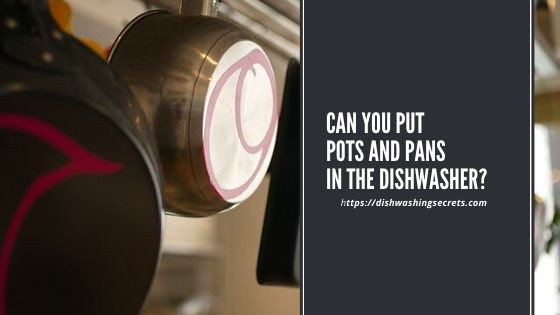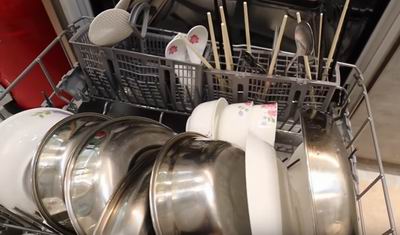
Washing cookware by hand is not a piece of cake. Have you got old pans? After several years of use, their surface becomes burned and greasy. You are to fight oil buildup and food residue. There are several useful tips on how to do it properly. But can you put pots and pans in the dishwasher? You should know what kind of material and coating manufacturers used. Buying a new cookware set or a separate piece, read instructions. Do you see a dishware-safe label in the booklet? There are still some cautions to use. It lets you prolong the life of your favorite cookware and keep it neat and shiny.
What Should You Not Put in Your Dishwasher?
It seems that a dishwasher can fix the problem. This time-saving device cleans your kitchen utensils more efficiently. Hot tap water and specially-formulated detergents clean stains from the metal surface. They cope with tough-on grease and buildup easily. Sticky food and stubborn baked-on messes have no chances to survive washing.
There are a lot of solutions, tablets, and powders that fight grease perfectly well. They remove limescale and burnt-on food. There are some exceptions and cautions. Why is it bad to put pots and pans in dishwasher? You are to scrape your dishes and cookware properly. Do it before putting them in your cleaning machine. Otherwise, grease might clog up your dishwasher. Fat and shortening leave a sticky residue on its walls, racks, and baskets.
Sensitive Metals and Materials

What about the tableware and cookware conditions? Manufacturers don’t recommend dishwashing pots and pans that contain:
- aluminum;
- copper;
- cast iron;
- non-stick coating.
Some metals might be dangerous in some conditions. Is aluminum in dishwasher toxic? The ATSDR Agency characterizes the metal as a hazardous substance. The cookware releases toxic particles into your food. It happens when you expose the surface to heat. Contacting acidic food is also not advisable.
But aluminum pots commonly come with durable coatings. Anodizing also protects you, preventing the elements’ leaching. Additionally, aluminum pots and pans are lightweight. They heat up fast and evenly. So, the inexpensive cookware is available in every kitchen nowadays.
Cast iron is a cheap, ferrous alloy. It’s prone to rust – long hot water exposure and soaking damages the surfaces. Any detergent or dishwashing soap removes seasoning. Acidic food like vinegar or citrus juice may strip the surface too. Avoid cooking them in your cast iron pan or skillet until you season it.
Can You Put Stainless Steel Pots in the Dishwasher?
Copper mugs and pots require hand-washing too. It should be remembered that their surface is prone to tarnishing. And harsh detergents spoil its shiny sheen. Is stainless steel silverware dishwasher safe? It should be the only metal that resists dishwashing. Let’s compare several food-grade alloys.
| SS Series | Cr Composition % | Ni Composition % | Mn Composition % | Corrosion Resistance | Oxide Resistance | Resistance to Acids |
|---|---|---|---|---|---|---|
| 200 | 15-18 | 1-6 | 5-15 | high | medium | good |
| 300 | 18-20 | 8-10 | 1-2 | high | medium | good |
| 400 | 11-16 | 0.5-0.7 | 1 | medium | high | acceptable |
Austenitic stainless steels are the most popular. Multiple alloys and grades from 200 and 300 series belong to this group. Can you dishwasher stainless steel? If your pot consists of 304L-grade metal, do it positively. It contains 18% of Chromium and 8-10% of nickel. Therefore, it’s durable, corrosion and rust-resistant. It’s a low-carbon, withstanding acid attack. The cookware is completely safe at the temperatures below 140 degrees Fahrenheit. When it reaches 158° F, more expensive, 316-grade steels are preferable.
400-series, ferritic steels don’t contain nickel. 430 type is the most common. It is less resistant to corrosion. But it withstands oxidizing solutions and acids perfectly well. Unless the temperatures are not high. Moderately corrosive environments don’t damage the surface. They might include vegetables, drinks, and dry foods.
Can You Put Calphalon Pots and Pans in the Dishwasher?
Pans with beneficial, non-stick coating are very popular nowadays. It’s a healthy option, as it requires less oil or fat to fry foods. The modern cookware is pretty affordable and easy to wash. Is its surface scratch-resistant and safe-to-use? Modern cookware is durable, non-toxic.
There are several types of innovative non-stick-coating, such as:
- PFTE.
- Ceramic.
- Silicone.
- Granite.
- Enamel.
- Hard-anodized aluminum.
Non-stick coating’s name is mud due to the PFTE polymer. Chemours Company used it in its famous brand Teflon since the 1950s. Polytetrafluoroethylene is strong and non-reactive. But these pans require special care. Metal utensils may scratch their delicate surface. The coating breaks down when the temperatures reach 450-500°Fahrenheit. If you overheat your cookware, it might release toxic fumes into your kitchen environment.
Ceramic coating is not as strong as PFTE. But it’s eco-friendly and much safer to use. The coating withstands high temperatures up to 842 degrees. It does not deteriorate, avoiding scraping or flaking.
Calphalon offers a wide range of durable kitchen products. Basic materials are stainless steel and aluminum. Stainless steel withstands dishwashing. Ceramic and hard-anodized aluminum non-stick coatings are safe and durable. But the manufacturer still recommends washing aluminum pots and pans by hand.
Where Do Pots and Pans Go in the Dishwasher?
Modern ceramic-coated frying pans and stainless steel pots go in your dishwasher. If the manufacturers label them as dishwasher-safe items, of course. Modern kitchen appliances do the job. They clean dirty, heavily soiled cookware pretty well. Most of them come with foldable tines. It lets fitting bulky pots and baking dishes on the bottom rack.
Loading your dishwasher:
- let hot cookware cool down;
- separate silver-plated and stainless steel utensils;
- place plates, bowls, and pots on the bottom;
- angle them down, facing towards the center;
- load utensils to the flatware baskets;
- don’t overload your cleaning machine.
Should you pre-rinse the things you can put in a dishwasher? It’s possible, but not obligatory. If you scrape the food particles off the surface, that’s enough. Above all, place glasses and cups on the top rack. They should go between the tines. After that select low-temperature (about 113 °F). A short, 1-hour wash cycle is preferable.
Final Words
Have you got a new cookware set recently? Read the instructions carefully. Type of material and coating matters. Stainless steel utensils should withstand strong detergents and high temperatures. Does your pan consist of aluminum or copper? Better wash it by hand. If the cookware is greasy, use only dishwashing liquid and warm tap water. Vinegar helps to remove stains and buildup. Soak burnt cookware in soapy water for a couple of hours. Apply baking soda on durable surfaces. Clean and maintain your pots and pans properly. Let them last for several years, looking shiny and new.
